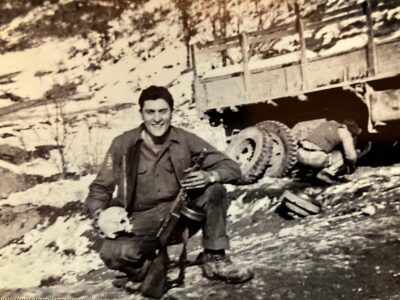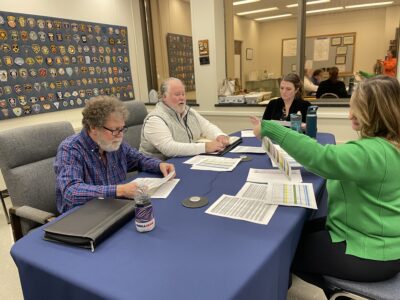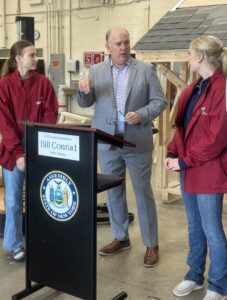Seneca Nation, JPS Respond To Rising Concerns With Mascot Name

Pictured is the current JHS logo on the back of the high school building. P-J photo by Cameron Hurst
An online petition to change the name of Jamestown High School’s mascot that started circulating this week has received a response from the president of the Seneca Nation of Indians.
Rickey L. Armstrong Sr., president of the nation — the largest of six Native American regions in New York state with its capital located in northern Chautauqua County — released a written statement to The Post-Journal Thursday reacting to the renewed interest shown by those who hope the district will change its longtime nickname from the “Red Raiders.”
“Seneca and Native American culture are reflected in the names of countless streets, towns and locations throughout Western New York,” Armstrong said. “Unfortunately, we also see the continued use of names and imagery, particularly in athletics programs, that degrade, mock, and offend Native traditions, Native culture, and Native people. The time for change has long since arrived, and the call should be heeded.”
The petition, named “Remove racist name & imagery from Jamestown Public Schools athletic teams” was posted by local resident Autumn Echo on Change.org and, as of Thursday night, had garnered nearly 400 signatures after being widely circulated across various social media channels.
“Jamestown Public School District has a long and proud history with football, and the city of Jamestown has rallied around our sports teams as a shining example of athletic success for our students throughout the years,” the petition states. “With a renewed energy and focus on fighting racial injustice and with communities and individuals working hard to promote a culture of anti-racism personally and within their own communities, we would like to petition the Jamestown Public School District to change the name “Jamestown Red Raiders” and remove any Native American imagery from their logo and all sports/school paraphernalia/buildings, etc.”
Dr. Bret Apthorpe, district superintendent, told The Post-Journal he was aware of the movement but had not been contacted personally by any of the organizers.
“For me, it has to be part of a much larger conversation on this topic,” he said. “I really do appreciate the awareness if indeed this petition is true and if indeed all of these people have signed it. To me, people have opened their eyes and ears and they want to participate as a part of that conversation that we need to have as a community.”
The petition notes that the nickname “Red Raider,” “is a racist term derivative of the slur ‘redskin’ and is inherently racist and harmful.”
“While I have not talked with anyone at all regarding this logo question, for me, it’s part of a much larger question and a much larger conversation that we have to have as a community around cultural sensitivity particularly within our changing demographics,” Apthorpe added, noting that the district and its board of education have committed themselves to engage in dialogue regarding cultural awareness.
“The school board and I, as we look at student achievement data and have looked at school climate surveys realize that Jamestown’s demographic is changing quite a bit,” he said. “About 40 percent of our students are minorities and a vast majority of them are Latino students. We look at Latino student results and climate surveys and student achievement and it’s very apparent that they are disengaged with their school and school community.”
To help engage minority students, he noted, the school board hired a diversity and cultural responsiveness expert, Dr. Sean Bradwell of Ithaca College, who spent a year working on an audit that included interviews and a range of student achievement data.
“He just shared with me a draft of that report and in it is a lot of disturbing information regarding how disconnected we’ve become with our minority students,” Apthorpe added.
While the Native American imagery was not directly referenced in the audit, Apthorpe also noted that any change must be done as a community so as to not run the risk of further polarization.
“I think Dr. Bradwell’s point was that there needs to be a constant dialogue on this topic because times change,” he said. “We have to move forward to change as a community. We can’t move forward with change as polarized groups. That’s no good. Whenever you make quick, impulsive changes to things, what you do is polarize people. So, in the case of this petition — and I have not met with anybody from this group — if indeed it’s a serious petition and we were to react immediately to change the logo, we would polarize our community.”
The issue surrounding the district’s mascot is not a new one: an April 6, 2001 story that ran in The Post-Journal noted that Richard Mills, former state education commissioner, had urged school board presidents and school districts to change their school’s mascot and nickname if it uses Native American symbols.
The district began to phase out a Native American character portrayal beginning in 2012. By 2015, all district athletic teams began using a capital ‘J’ with a feather at the direction of former superintendent Tim Mains.
“That was done on the district’s own fruition,” Apthorpe noted. “There was no pressure to do that, but times do change.”
The petition considers the use of the decorative feather “a common nod to Native American culture, and implies an appropriation of Native American headwear.”
Still, while Apthorpe was not able to speak to whether or not the board of education would address concerns regarding mascot, he believes the board will continue to make addressing cultural sensitivity a priority.
“The board has already committed themselves for over a year to a larger conversation around cultural sensitivity,” he said. “Whether or not the logo is part of that remains to be seen, but the board of education formally committed themselves to this over a year ago.”
According to Armstrong, the nation stands ready to partner with districts who choose to move forward in that effort.
“Cultural tolerance and sensitivities are an important part of the national and local dialogue,” he said. “As educational institutions, local school districts can now teach an important and valuable lesson in their communities. Unity and tolerance begin with dialogue, respect and understanding. We are open to being partners in the important conversations that need to happen so that our community can positively reflect all of its residents and the history that shaped Western New York.”






